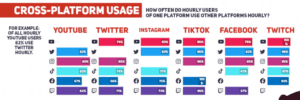The in-depth knowledge of social media behaviors across various generations is the key to any great marketer out there.
Since every generation has different advertising, content, and brand communication expectations, you need to step up your game and clearly understand the preferences of each age group. There is no secret one size fits all approach that will work for Gen X, Y, and Z at the same time.
Ever-changing social norms and trends made trying to reach younger audiences gradually more and more challenging in recent years. Brands have no choice but to learn, adapt quickly to this new reality, and stay relevant – otherwise, they will be left behind as the competition takes over the market.
To help you out in understanding the new digital advertising landscape, Adshot recently published the Global State of Gen Z & Y Research Q3/2020.
Ensuring neutral results, we examined 343 people from across the globe. We analyzed two age groups: 5-25 (Gen Z) and 26-10 (Gen Y). We put their media behavior, including social media use, attitude towards advertising, and gaming content consumption under investigation to give you some raw data and insight.
How does Gen Z use social media?
The social media use of Gen Z is excessive, to say the least.
Over 82% of the respondents stated that they use YouTube daily, with 45% of them doing it on an hourly basis.
Similar numbers are true across multiple other platforms. 73% of respondents use Twitter daily, 27% of which do it every hour. Instagram follows the same pattern, with 72% of respondents using it daily, and 27% doing it hourly.
TikTok and Twitch are strikingly similar to each other, with 51% of respondents using both of those platforms on at least a daily basis. 40% of Tik Tok users check it at least every hour, and comparably, 39% of Twitch users watch it hourly.
Facebook, as a less content-intense platform, attracts over 75% of our respondents at least once per day but has the lowest percentage of people visiting it hourly at only 24%.

Those super-social-media-users that tend to visit a specific platform at least every 1-2 hours, tend to be extremely active across multiple social media sites at the same time.
For example, YouTube super-users that watch videos hourly will also use Instagram every hour in 72% of all cases, Twitter and TikTok in 68% of all cases, and Twitch in 64% of all cases.
This synergy, although it is prevalent across the board, is most visible in the following instances:
Gen Z and video games
Over 90% of male Gen Z respondents play video games and watch gaming-related content online across a variety of platforms.
69% of our female respondents also play games, but only 59% of them are actively spending their time watching gaming content online.
How to tackle advertising to Gen Z?
Gen Z has a strong, negative attitude towards both ads and video ads. This is strikingly visible in their use of Adblock. Our respondents had it installed on their PC (49%) and, in some cases, on their smartphone (24%). Since this generation is heavily turned off by any form of invasive and interruptive promotion, marketers’ focus should turn to other types of advertising if possible.
Gen Z doesn’t mind sponsored influencer content – on the contrary, they had quite a positive outlook on it. By taking advantage of this trend and the desire to interact with people online, you can create much more impactful digital campaigns to target this group.
How does Gen Y use social media?
Gen Y, although still invested in their social media presence, seems to have a vastly different platform preference to Gen X.
63% of all responders use Instagram daily, and 28% of them check it hourly.
Twitter holds a steady position with 45% of people using it on a daily basis, and 31% of all respondents checking it and commenting at least every hour.
43% of the respondents stated that they use YouTube every day, with 28% of them using the platform on an hourly basis.
37% of people use TikTok daily, with over 23% of all users visiting at least every hour. A similar pattern emerges for Twitch, with 37% of all respondents frequenting it daily and 22% watching it hourly.
As with Gen Z, Facebook also attracts a strong 44% of our Gen X respondents every day but has the lowest percentage of people visiting it hourly at only 19%.
Social media super-users that check various platforms every hour are also more apparent, with the most extreme examples being:

Gen Y and video games
86% of all male Gen Y respondents play video games in their free time, and 89% of them enjoy watching gaming content online. This is true for 73% of our female respondents who play video games regularly. Almost 60% of them also admitted that they watch gaming content online.
How to tackle advertising to Gen Y?
Gen Y respondents don’t seem to mind ads in general, but they are not on board with video ads at all. Their general overview of disruptive, noisy commercials is profoundly negative.
That is why over 66% of our respondents had some form of Adblock installed on their PC. 29% of them also had ad-blocking software present on their mobile.
However, sponsored influencer content, as in the case of Gen Z, was favorably viewed. This again suggests that when investing in digital marketing campaigns, strong emphasis should be put on reliable, honest, and real influencer content rather than traditional ads.
For a more detailed overview of the topic, download our Global State of Gen Z & Y Research Q3 – 2020 for free here.